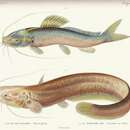Indus River Habitat
provided by EOL authors
The 180 cm Long-whiskered catfish (Sperata aor) is one of several native high trophic level demersal (organisms living on or near the bottom) fish species present in the Indus River and its tributaries. Major tributaries of the Indus rise in the Himalayan Mountains and the Hindu Kush; these influent rivers include the Chenab, Jhelum, Ravi and Sutlej. The Indus mainstem rises on the Tibetan Plateau and flows generally westward. The Green Revolution has exacerbated water pollution by considerable additions of nitrate to promote crop growth. Other aggravating factors have included increasing amounts of herbicides and pesticides, as pressures to increase crop production expand. Flow of the perennial Indus is dominated by: (a) meltwaters from the Tibetan icefield, the third largest ice sheet formation in the world; (b) snowfall and snowmelt from higher elevation of the watershed; and (c) episodic monsoonal rains that lead to periodic flooding in the basin. Other large demersal fish associates in the Indus Basin are the 244 centimeter (cm) giant devil catfish (Bagarius yarrelli),, the 150 cm giant river-catfish (Sperata seenghala), the mottled loach (Acanthocobitis botia), silond catfish (Silonia silondia) and the 150 cm near threatened clown knifefish (Chitala chitala).
- bibliographic citation
- C.Michael Hogan. 2012. Indus River. Eds. P.Saundry & C.Cleveland. Encyclopedia of Earth. National Council for Science and the Environment. Washington DC
- author
- C. Michael Hogan (cmichaelhogan)
Diseases and Parasites
provided by Fishbase
Isoparorchis Infestation. Parasitic infestations (protozoa, worms, etc.)
Diseases and Parasites
provided by Fishbase
Bucephalus Infestation 3. Parasitic infestations (protozoa, worms, etc.)
Diseases and Parasites
provided by Fishbase
Bucephalus Disease. Parasitic infestations (protozoa, worms, etc.)
Diseases and Parasites
provided by Fishbase
Prosorhynchoides Disease. Parasitic infestations (protozoa, worms, etc.)
Diseases and Parasites
provided by Fishbase
Coitocaecum Disease. Parasitic infestations (protozoa, worms, etc.)
Diseases and Parasites
provided by Fishbase
Caryophyllaeus Infestation. Parasitic infestations (protozoa, worms, etc.)
Diseases and Parasites
provided by Fishbase
Contracaecum Infestation 1. Parasitic infestations (protozoa, worms, etc.)
Diseases and Parasites
provided by Fishbase
Paragendria Disease. Parasitic infestations (protozoa, worms, etc.)
Diseases and Parasites
provided by Fishbase
Pingus Infestation. Parasitic infestations (protozoa, worms, etc.)
Migration
provided by Fishbase
Potamodromous. Migrating within streams, migratory in rivers, e.g. Saliminus, Moxostoma, Labeo. Migrations should be cyclical and predictable and cover more than 100 km.
- Recorder
- Crispina B. Binohlan
Trophic Strategy
provided by Fishbase
Found in rivers, ponds, lakes, channels and reservoirs (Ref. 4833). Predatory, feeds on small fishes and worms (Ref. 44149).
- Recorder
- Grace Tolentino Pablico
Biology
provided by Fishbase
Found in rivers, ponds, lakes, channels and reservoirs (Ref. 4833). Predatory, adults feed on small fishes and worms (Ref. 44149). Oviparous, distinct pairing possibly like other members of the same genus (Ref. 205).
- Recorder
- Crispina B. Binohlan
Importance
provided by Fishbase
fisheries: commercial; gamefish: yes
- Recorder
- Crispina B. Binohlan
Sperata aor
provided by wikipedia EN
- license
- cc-by-sa-3.0
- copyright
- Wikipedia authors and editors
Sperata aor: Brief Summary
provided by wikipedia EN
Sperata aor, the long-whiskered catfish (Bengali: আইড় aiṛ, Assamese: আঁৰি ãri), is a species of catfish of the family Bagridae found in southern Asia in the nations of India, Pakistan, Nepal, Bangladesh and Myanmar. It grows to a length of 180 centimetres (71 in) and is commercially fished for human consumption. It is also a popular gamefish.

Sperata aor of Bangladesh
- license
- cc-by-sa-3.0
- copyright
- Wikipedia authors and editors


 Sperata aor of Bangladesh
Sperata aor of Bangladesh